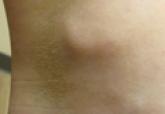Article

Clinical Pearl: The Squeeze Maneuver
Plantar warts can be distinguished from calluses using the squeeze maneuver, a quick and easy method to diagnose plantar warts. This technique...
Dr. Lipner is from the Department of Dermatology, Weill Cornell Medical College, New York, New York. Dr. Iorizzo is from private practice, Bellinzona, Switzerland.
The authors report no conflict of interest.
Correspondence: Shari R. Lipner, MD, PhD, 1305 York Ave, New York, NY 10021 (shl9032@med.cornell.edu).
Psoriatic arthritis (PsA) is more common in patients with nail psoriasis. Radiograph imaging is a quick, inexpensive, and valuable diagnostic technique for PsA in patients with nail psoriasis.
Early diagnosis of nail psoriasis is challenging because nail changes, including pitting, subungual hyperkeratosis, crumbling, oil spots, salmon patches, onycholysis, and splinter hemorrhages, may be subtle and nonspecific. Furthermore, 5% to 10% of psoriasis patients do not have skin findings, making the diagnosis of nail psoriasis even more difficult. Psoriatic arthritis (PsA) is more common in patients with nail psoriasis than in those with cutaneous psoriasis, and early joint damage may be asymptomatic.1 Both nail psoriasis and PsA may progress rapidly, leading to functional impairment with poor quality of life.2
A 36-year-old man presented with a 4-year history of abnormal fingernails. He denied nail pain but stated that the nails felt sensitive at times and it was difficult to pick up small objects. His medical history was notable for type 2 diabetes mellitus, hypertension, and attention deficit disorder. He denied joint pain or skin rash.
Physical examination revealed pitting and onycholysis of the fingernails (Figure, A) without involvement of the toenails. A nail clipping was negative for fungus but revealed an incompletely keratinized nail plate with subungual parakeratotic scale, consistent with nail psoriasis. A radiograph showed erosive changes of the third finger of the right hand that were compatible with PsA (Figure, B).
A nail clipping may be performed to diagnose nail psoriasis. Imaging and/or referral to a rheumatologist should be performed in all patients with isolated nail psoriasis to evaluate for early arthritic changes. If present, appropriate therapy is initiated to prevent further joint damage. In patients with nail psoriasis with or without associated joint pain, dermatologists should consider using radiograph imaging to screen patients for PsA.

Plantar warts can be distinguished from calluses using the squeeze maneuver, a quick and easy method to diagnose plantar warts. This technique...

Alcohol can be used as a diagnostic aid for patients with dyschromia commonly seen in terra firma-forme dermatosis, confluent and reticulate...


